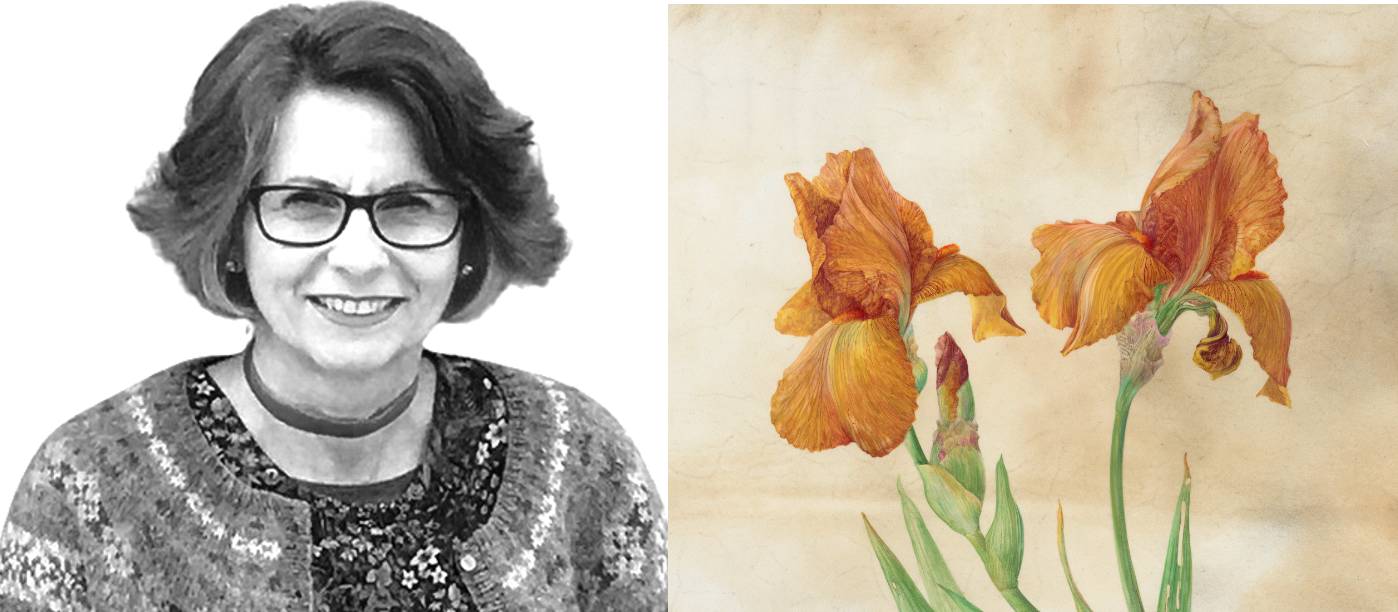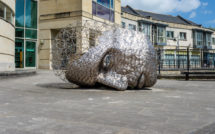

This is part of our special feature, Rethinking the Human in a Multispecies World.
The field of plant studies is relatively new and spans a wide range of disciplines, from neurobiology to ecology to philosophy and anthropology. In the natural sciences, the notion of plant sentience remains controversial, in part due to the language scientists use to describe what they observe. Evolutionary ecologist Monica Gagliano[1] and neurobiologist Stefano Mancuso[2] are the rare exceptions who embrace human subjectivity as a tool for understanding plants as sentient beings capable of learning, remembering, and collaboration. Botanical artists, on the other hand, seem ideally positioned to traverse the disciplinary boundaries between the natural sciences and arts and humanities. Perhaps more important in our current life-threatening crisis of biodiversity is the power of botanical art to inspire humanity’s respect for the vegetal world by fostering strong and lasting emotional bonds between the plant subject and human viewer. My conversation with English botanical artist Gael Sellwood began with questions about how she seeks to inspire appreciation for plants’ scientific complexity and inherent beauty and wonder about all we still don’t know about them.
–Elizabeth B. Jones for EuropeNow
EuropeNow I’m especially interested in the ways your art crosses boundaries between “visual plant art,” “tactile plant art” (such as making plant dyes), and “plants as art,” or, “the appreciation of botanical nature on its own terms.”[3] How do you understand the work you do? In particular, how do you think about faithfulness in your portrayals? Do you seek to balance scientific rigor with aesthetics or something else entirely, and how has your approach to the art of botanical representation evolved over the course of your career?
Gael Sellwood As well as being a botanical and natural history artist, I am also an avid maker. I stitch and sew almost solely using naturally occurring materials, and even often dyes. I love that natural things are almost always, if used wisely, renewable and reoccurring. My work started nearly 30 years ago and although by approach has sustained core themes and values throughout that time, it has evolved over the course of my painting career to date, and I expect it to continue to evolve and develop in the years to come. While scientific rigor and attention to detail and accuracy are completely critical in plant representation, the overriding essence of my work is to create an emotional connection with the plant, in order to evoke a sense of place or time, as well as elicit other emotions leading to a hopefully positive experience for the viewer. Maybe, in time, it will also be about provoking thought and even discomfort. My work always seeks to be faithful to the subject, however that never stops the artist from manipulating the subject so that, unlike in photography, you can paint one flower from one position, turn your subject and paint another flower from another position. This way more of the spirit of the plant can be captured within the painting and this further adds to the message within the work. The connectedness between the subject, the artist, and the viewer or owner is something that has continued as another theme from the very inception of my career as an artist. My passion is imagery and symbolism. The symbolism is there for the viewer to determine, and sometimes its intent is made clear through the titling of a piece or, on occasion an added description.
EuropeNow The ethno-botanist Kay Lewis-Jones, along with many others, have called on scholars in the humanities and social sciences to “engage with and contribute to the discussion and rediscovery of plants as agents in our world.” How do you see your work grappling with new scientific research on plant sentience, emotion, learning, and as active social beings?[4]
Gael Sellwood It was through a “free writing” exercise as part of a postgraduate program that I really became clear that imagery and symbolism were key elements of my work. To this extent, I developed a commissions service that invites the client to work with me in the development of the chosen subjects, and on occasion their placement. The ideas within these plant portraits are multiple. Initially, the portrait is about recreating the plant as it is seen. However, taking this further, the portrait becomes about the depiction of a person, a place, or a time and will take the viewers to that sense or feeling that they associate with that person, place, or time. For example, a painting that reflects the client’s grandmother may contain plant elements from her garden, so that a further discussion or exploration of how that garden is presented will help to determine the layout and to a certain extent the style of the depiction of the plants. Will it have a slightly faded or genteel feel, will it be very bold or quite soft?
In relation to the plants as sentient beings, I realize that they have always been thus for me and as such it is important to me to create the forms in such a way as to reflect on that. For example, I will ensure that the shapes and characters presented are characteristic of the plant, but also that they carry the forms and shapes that are somewhat emotional in their presentation. I guess this could be argued as being the anthropomorphizing of plants, but it is a far more subtle endeavor.
The current evolution of my work is to consider whether it is possible that as an animal species, we have any sense of instinct, or whether our intellect and cognitive abilities mean that we have all but lost any innate senses. I remember watching a mother hen with chicks in our hen run and being struck by the way in which her movements and the subtle tilt of her head and eyes, combined with the sound she made, would communicate with these little fluffy chicks what was safe, and what was not, in terms of eating. There were some ragwort plants and the caterpillars of the cinnabar moth feed on these plants. The caterpillar is colored in such a way that it is normally considered to carry a warning sign to animals not to eat it. Obviously, I will never know whether the chicks had this innate sense, or whether the mother hen was communicating this. In any case, how did she know? I’m very interested in whether we carry any sense of what is good for us or not good for us. This is in the very specific sense (will it hurt us if we eat it or touch it?) as well as in the broadest sense in terms of plants being the key to carbon sequestration and also taking in carbon dioxide and converting it to oxygen as plants carry out respiration.
My work also attempts to remind the viewer of the sheer beauty and the simplicity of nature as well as the diversity of the forms, textures, and colors within the natural world. It feels as though as humans we are bent on creating evermore intricate, manufactured, and artificial elements of what we consider beautiful and the object that we hold to be a value. In this materialistic world it can seem that acquisition is a constant. I am keen to convey the simplicity and beauty of the natural world and to remind all of us that if we just take a few moments to explore the rosehips in the hedgerow, we will realize that these have all the beauty of rubies, while free and renewed each year. We cannot tire of them because they are transient—so boredom cannot creep in. Surely, these can be more precious than some manufactured “gem” or artifice with which we decorate our homes and continue to pollute and degrade the very planet on which we depend. The possibilities are endless in terms of the power to convey messages through the sentience of plants. The trick for an artist, as opposed to a skilled technical illustrator, is how explicit to make the message or whether to allow the beauty of the artwork to sell the message itself and to try and convey that we ignore the natural plant world at our peril.
I have used this conversation to look back on recent pieces of work and realized that there is often a reflection of the sense or feeling of events currently being experienced in the world. Here in the UK, a few summers ago, we faced a profound change after just over half of the population who voted, voted for Britain to leave the European Union. In the run-up to this referendum, opinion was very divided, and feelings ran very high. I painted two iris compositions at that time. I deliberately placed them so that in one composition they were “Standing together,” and in the other they were “Standing apart.” It felt as though the plants were speaking to me: the profound depth of the black in the deep black iris seemed to have no end, reflecting and responding to the mood at the time. Even within close-knit family and friend groups, individuals were at loggerheads and could not understand, contain, or even contemplate the feelings of those close to them if they were at odds with their own. The attitude of the flowers and their stance, relative to one another, captured the polarized nature of human relations in the UK at the time. A similar series has been developed, I realize in hindsight, in response to the onset of the pandemic situation in 2020/2021. These are some portraits of roses “Looking forward” and “Looking back” and “Feeling optimism” and “Feeling blue.” The moods are captured in the direction in which the roses are facing, as well as the tilt of the flower heads. I hope that these pieces convey an emotion or an attitude.
This brings me back to the anthropomorphizing of the plant. I fully expect and allow my subject to strike an attitude. Again, this can be manipulated within the painting to convey a cheeky shrug of the shoulder or a nonchalant glance. The plant is not animate, but perhaps, as an animal species, if we do attribute animate characteristics to the plant then we can place a higher value upon it and, as we seem to try and hold onto things we value, then plants might stand a better chance at the hands of the human animal. In my work, the contribution to the discussion and rediscovery of plants as agents is perhaps tacit and simply there for the viewer to discover. There is wide-ranging debate and discussion within the art world about whether artists need to or even should express the intention or message within their artwork. Some critics believe that to explain is to denigrate and devalue the work because the meaning is in the eye of the beholder and is not for the artist to describe verbally. Only time and will tell if my future artwork becomes more explicit.
EuropeNow Are botanical artists uniquely positioned to mediate new conversations about plants, and new understandings of them, between the natural sciences, the humanities, and the public? Do we have anything to learn about this hybrid knowledge from the centuries-long traditions of botanical art in human culture?
Gael Sellwood Botanical artists are positioned very well to mediate new conversations about plants and understandings, in particular the connections between natural sciences, the humanities, and the public. This tradition of plant illustration has a long history. Some of the earliest, most decorative, and accurate depictions of plants were illustrations and illuminations on manuscripts. Often religious, these often contained messages and the plants and flowers depicted had a particular commonly understood meanings. Whilst not directly related to plant sentience, obviously the notion of communication via an image was clearly understood by both illustrator and viewer. In 1597, British botanist John Gerard published a herbal that featured 1,800 woodcut illustrations, including one of the first images of a potato. His herbal aimed to show what plants would kill, feed, and cure.
In Renaissance Europe, there were a number of notable artists who painted flowers, commissioned by important patrons, who developed considerable collections of botanical artwork. Although their goals were fundamentally different from the plant collectors who explored the new world and who usually took an artist or illustrator along (for example, Captain Cook who recorded hundreds of plant species from the New World had taken Sydney Parkinson with him on the Endeavour)), the similarity arises in relation to discovery, acquisition, value, and exploitation of plants. At that time, the depictions were about the function, use, value, or potential of a particular plant species, as well as the opportunities for its use or cultivation in the future. It seems that there is a resonance with today’s connection with this mode of communication as a way to inform, educate, and support positive decision-making about human activities. On examination of some of the earlier illustrations, it is obvious that there was a huge excitement about and enthusiasm for the subject. The idea of adventures through which plants were collected in order to explore them, whether for scientific reasons or for exploitation by humans, seems as relevant today as it was historically. Today, there are still dictionaries published on the language or meaning of flowers and the past excitement and enthusiasm about the potential value and use of a plant could be the key to enchanting future generations about the importance of and opportunities with plants.
EuropeNow What are you working on at the moment, and how do you feel your future work might be influenced by the present threats to plants posed by human activity?
Gael Sellwood Current and future projects include the development of a body of work that reminds us of our dependency on plants, how we exploit them often without thought. I use historic papers from Darwin’s times to convey plants that we use to enable us to evolve. At the moment, these projects are in the delicious daydream stage and drifting thoughts—but I am a believer that “in dreams begins responsibility.” I am intrigued that without wood we would not have timber framed buildings, without straw we would not have thatched roofs (under which I lived for over 25 years), and without rubber we would not have the tire. Reminders of our reliance on the natural world are necessary, if only to convince us all to husband and use these resources with care.
The second project, which has been on the back burner, gently developing over the last couple of years now (paper ready in plan chest), reminds me of how humans seem to be such a hopeless species at evolving. In my view, we think we are actually very highly developed and inordinately evolved; I contend instead that we are just very good at manipulating and exploiting our environment and thousands of other species of animal and plant—to make our world (at least in the short term) more comfortable. We gain knowledge, call it wisdom, and think we add meaning to convey to one another information on which decisions and actions are taken. For myself, I will just carry on depicting and painting, thinking with care about the messages in the very objects―implicit, explicit―and the sentience of plants. In conclusion, to suggest that plants are sentient beings, feels almost to be an over simplification. The botanical artist can bring so much more to the canvas, and there is so much more to explore and to contemplate. Even if in the purest sense, plants cannot be sentient, it seems that acceptance of the notion of even liminal sentience cannot help but bring us benefits, pleasure, and knowledge.
Gael L. Sellwood has worked as a botanical and natural history artist over the last thirty years Following a successful career in consultancy work, botanical painting is now her main occupation. Her work details “found” natural objects affected, renounced, and used by nature; usually in watercolor on paper (sometimes on vellum). She has worked in The Hunt Institute of Botanical Documentation in Pittsburgh, The Lindley Library of the Royal Horticultural Society, London, and the Shirley Sherwood Collection and received gold medals from the Royal Horticultural Society and the Scottish RHS.
Elizabeth B. Jones is Professor Emerita of German and European history, Colorado State University. Her scholarship covers all aspects of rural Germany, with emphasis on the nineteenth and early twentieth centuries. She currently lives in Corvallis, Oregon and works with several community non-profits involved in social and environmental justice and looks after a small forest.
References
[1] Gagliano, Monica. 2018. Thus Spoke the Plant: A Remarkable Journey of Groundbreaking Scientific and Personal Encounters with Plants. Berkeley: North Atlantic Books.
[2] Mancuso, Stefano. 2018. The Revolutionary Genius of Plants: A New Understanding of Plant Behavior, trans. Vanessa Di Stefano. NY: Atria Books.
[3] Ryan, John Charles. 2015. “Plant-Art: The Virtual and the Vegetal in Contemporary Performance and Installation Art,” Resilience: A Journal of the Environmental Humanities 2, No. 3, 40-57.
[4] Lewis-Jones, Kay E. 2016. “Introduction: People and Plants,” Environment and Society 1-7.
Published on November 9, 2021




